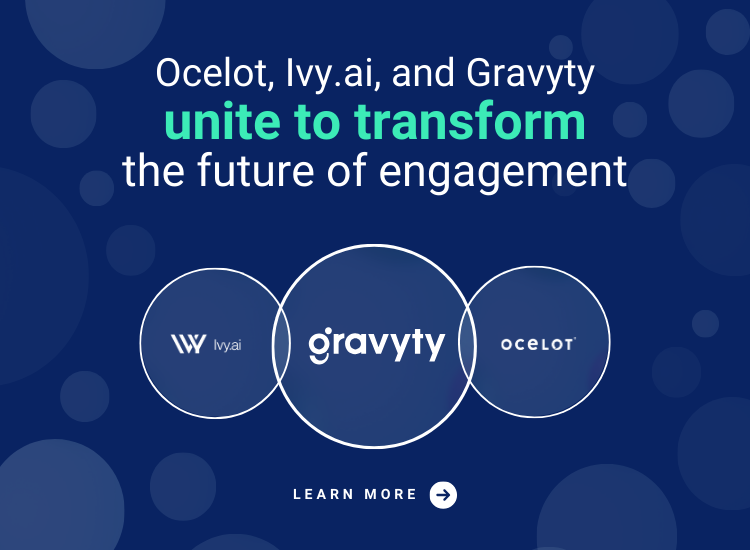Over the past two years, colleges have faced unprecedented challenges and confusion communicating with students.
Higher education teams had to act quickly in addressing COVID-related communication issues. Many responded by rolling out an AI Chatbot, providing 24/7 communication, and others relied more heavily on text messaging, but it was still an uphill battle to ensure accessibility and a consistent experience for all students.
One specific hurdle was understanding the student perspective. How much were these changes impacting (or even multiplying) barriers? In order to better understand the situation, Ocelot recently conducted an independent survey with over 300 higher education stakeholders.
The survey results magnified wins and pain points for academic institutions. In a recent webinar, Keith Monteverde, Senior Vice President at Ocelot, reviewed the results and discussed issues in accessibility and inclusion with a panel of DEI experts. The panelists shared best practices, challenges, and opportunities when using technology to implement inclusive resources in schools.
Key learnings from the discussion are detailed on our blog in a six-part mini-series focused on removing barriers to access and inclusion.
Tackling Access and Inclusion: Where Do We Begin?
Joining Monteverde were Lucy Greco, an Accessibility Evangelist and Consultant with UC Berkeley, Jeff Singleton, a Digital Accessibility Professional at Converge Accessibility, and Candace Kauffman, Director of AI Conversation Design at Ocelot.
Ocelot’s survey reveals that financial guidance, clarity, and accessibility caused friction for students. Primary pain points included confusing systems, out-of-date interfaces, and complex terminology when navigating services such as financial aid.
Kauffman specifically highlighted the barriers that begin at the application stage with first-generation students, “There’s so much complexity around this field that makes it really difficult for a student, especially a first-generation student who is (the) first exposed to this terminology. It can really be a barrier to them.”
Survey results also revealed that this lack of access had a direct correlation to students dropping out or failing to complete their application process.
Monteverde notes, “Students that don’t understand how to pay for college and have financial aid and tuition issues are more likely to just drop out of the application process altogether or have significant debt after graduation … prospective students that can’t easily access information about admission requirements and lack support are less likely to complete the application process.”
With barriers beginning at the start of a student’s higher education journey, what can your faculty do to find a solution?
Empathy: A Key Aspect of Mindset
Creating a barrier-free and inclusive future doesn’t have to be hard; but it often is, especially for teams that are not accustomed to placing elevated importance on accessibility and inclusiveness in their work.
It is becoming paramount that all devices, communication, and platforms be inclusive and accessible. The biggest part of this change requires education and empathy.
“We need diverse students. We need persons with disabilities. We need all of these populations to attend the institution.” – Candace Kauffman, Director of AI Conversation Design at Ocelot
Greco, who is visually impaired, oversees the training dedicated to accessibility for the entire University of California system and partners with Ocelot to test and proof new tools prior to rollout.
Greco acknowledged that one of the main things about her role is that “not everyone actually understands disability or understands how to create accessible technology for people with disabilities.” Due to this lack of knowledge, and community connection, accessibility qualifications or needs turn into “something that most people who are working on these systems aren’t aware of.”
Greco and Kauffman shared a valuable, eye-opening experience when Greco struggled with technology in front of Kauffman’s team. Greco was in the middle of testing a new tool at UC Berkeley when her screen reader became incompatible. As she struggled in front of the group, challenges became clear that no one else had ever thought of because no one else on the team was visually impaired.
According to Greco, this experience is common. Often solutions arise only after an institution puts a face to the problem. As a direct result of Greco’s observed struggle, the problem was fixed within days.
A proactive mindset can be the key to bringing your team into the future with inclusivity and access. As Monteverde summarizes, the first step is awareness and developers having a thoughtful nature. “Making it part of the process and accepting that there isn’t an ‘easy button.’”
Awareness at every level of higher education is the key to creating an inclusive and barrier-free experience for all students. From acceptance to enrollment and throughout the duration of their study, enabling the right tools will deliver access, clarity, and confidence.
By breaking down barriers today, higher education institutions can empower faculty to create an accessible student experience with the right tools and a proactive mindset.
And by ensuring that the first impression is accessible to all, prospective students will get a glimpse into the inclusive approach they can expect when forging their own academic paths at your institution.
_____
Excited to learn more about inclusion and accessibility in higher education? Stay tuned for more content about why access and inclusion efforts are so hard.








